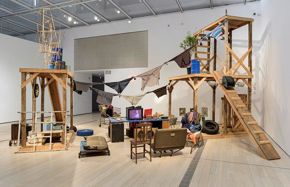The Idea of “HOME”: An Interview with Curator Chon Noriega December 8, 2017

Abraham Cruzvillegas, Autoconstrucción, 2013, installation, courtesy of the artist and kurimanzutto, Mexico City. © Abraham Cruzvillegas / Photo © Museum Associates/LACMA
Chon Noriega, director, UCLA Chicano Studies Research Center Photo by Felicia Lasala
An exhibition takes a village—and lots of expertise—to mount. HOME—So Different, So Appealing, with more than 100 works from 39 U.S. Latino and Latin American artists, is a joint effort of three institutions: the MFAH, the UCLA Chicano Studies Research Center, and the Los Angeles County Museum of Art (LACMA).
Chon Noriega, director of the UCLA Chicano Studies Research Center, is one of the curators—along with Mari Carmen Ramírez of the MFAH and Pilar Tompkins Rivas of the Vincent Price Art Museum. Noriega (pictured in image 2 of the slideshow) spoke about the impact of HOME, which debuted at LACMA earlier this year.
How is HOME different from other exhibitions of Latino or Latin American art that you’ve worked on?
In most cases, a curator starts with a premise about “Latino” or “Latin American” as social and/or cultural categories, then presents work that fits under that definition. We wanted to come at it from the other direction, so we started with a more general question about “home” in the latter 20th century and then looked at what the artists were doing in relation to that theme.
This approach made for a very different kind of exhibition—one that had a lot to say not only about Latino and Latin American cultures and societies, but also about the breakdown of the idea of “home” around the world since the 1950s. HOME is also unique in bringing together artists that have not been thought of in relation to each other. But once you see the exhibition, it makes immediate sense how these artists participated in a decisive change in the nature of art, from traditional forms to mixed-media and conceptual art.
How does this exhibition speak to both Los Angeles and Houston audiences?
In Los Angeles, HOME resonated broadly, drawing a diverse and younger audience of more than 130,000 visitors, half of whom were visiting LACMA for first time. Los Angeles and Houston have a lot in common: Respectively, they are the second and fourth most populous cities in the country, and also the biggest U.S. cities in which Latinos are the largest population group, making up nearly half of each city’s population.
So, looking at the universal concept of “home” through the filter of Latino art makes a lot of sense—doing so is true to both cities’ demographics, and it also provides a new way to appreciate something we all experience. The exhibition speaks to the country’s anxieties about home today. We’ve become a “nation of immigrants” that now targets immigrants based on race and religion.
HOME features many installations—some small, some monumental. What were the challenges of getting this exhibition ready twice?
This show was certainly a logistical challenge. HOME has large-scale work across several mediums, and for practical reasons, the crates could not be removed right away: It was like trying to arrange household furniture without first throwing out all the boxes the furniture had arrived in.
In terms of the two museums, the spaces are roughly the same size, but the configurations are very different. In Houston, we had to double up thematic sections in two gallery spaces, which actually allows us to explore some of the connections across themes.
What do you hope visitors take away?
The power of art to help change how we look at ourselves and the world; an appreciation of the amazing group of artists from across the hemisphere; and a sense of the deep connection between home and museum, as well as between art and everyday life.
See “HOME—So Different, So Appealing,” on view in the Law Building through January 21.





